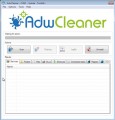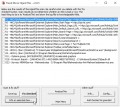There are many types of malware and one of them is ‘ad-supported’ software (also known as adware). The ad supported software, which causes the appearance of Addonsmash advertisements, have a negative impact on the functioning of your system. It modifies PC system settings, generates a large amount of advertisements signed with “Ad by Addonsmash”, slows down the FF, Chrome, Internet Explorer and Edge browser and the speed of your internet connection. The main function of the adware is showing ads, so it may redirect your web browser to an annoying web page, instead of the one that you want to visit. Even if you try to type an address into the internet browser’s address bar, then the internet browser is anyway, will display an unwanted ad web page.
Most often, the ad-supported software affects the most common web browsers such as the FF, Chrome, IE and MS Edge. But such the harmful software as well may infect another browsers by changing its shortcuts (adding an argument such as ‘http://site.address’ into Target field of a browser’s shortcut). So every time you launch the web-browser, it’ll redirect to the annoying addonsmash ads. Even if you setup a new homepage, an unwanted site will be the first thing you see when you start the Chrome, Mozilla Firefox, Internet Explorer and Microsoft Edge.
While your PC system is infected with the ad-supported software, the Google Chrome, IE, Mozilla Firefox and Microsoft Edge may be redirected to addonsmash annoying ads. Of course, the adware may not cause damages to your files or Windows system, but it may show a huge number of unwanted advertisements. These ads will be injected within the content of pages that are you opening in your web browser and can be varied: pop-up ads, in-text ads, different sized banners, offers to install an questionable software. The ads will appear on all web-sites, including sites where previously you have never seen any advertising links.
Instructions, which is shown below, will allow you to clean your PC system from the adware as well as delete addonsmash annoying pop-up ads from the Chrome, Firefox, Internet Explorer and MS Edge and other web browsers.
How to addonsmash ads get installed onto PC
Most often, the ad-supported software gets on your computer as a part of various free software, as a bonus. Therefore it’s very important at the stage of installing software downloaded from the Internet carefully review the ‘Terms of use’ and the ‘License agreement’, as well as to always choose the Advanced, Custom or Manual installation mode. In this mode, you can turn off all unwanted add-ons, including an adware, that can be installed along with the desired program.
How to manually remove ads by addonsmash adware
The simple answer is right here on this page. We have put together simplicity and efficiency. It’ll help you easily to clean your personal computer of ‘ad supported’ software. Moreover, you can select manual or automatic removal method. If you are familiar with the personal computer then use manual removal, otherwise use the free anti-malware utility designed specifically to remove adware which causes annoying addonsmash pop-ups. Of course, you can combine both methods. Read this manual carefully, bookmark or print it, because you may need to close your internet browser or reboot your PC.
- Remove suspicious and unknown software by using Windows Control Panel
- Delete ads by addonsmash from Mozilla Firefox
- Get rid of addonsmash ads from Chrome
- Get rid of addonsmash from IE
- Disinfect the browser’s shortcuts
- Get rid of unwanted Scheduled Tasks
Remove suspicious and unknown software by using Windows Control Panel
First, you should try to identify and uninstall the program that causes the appearance of unwanted advertisements and internet browser redirect to unwanted web pages, using the ‘Uninstall a program’ which is located in the ‘Control panel’.
Windows 8, 8.1, 10
Press Windows key
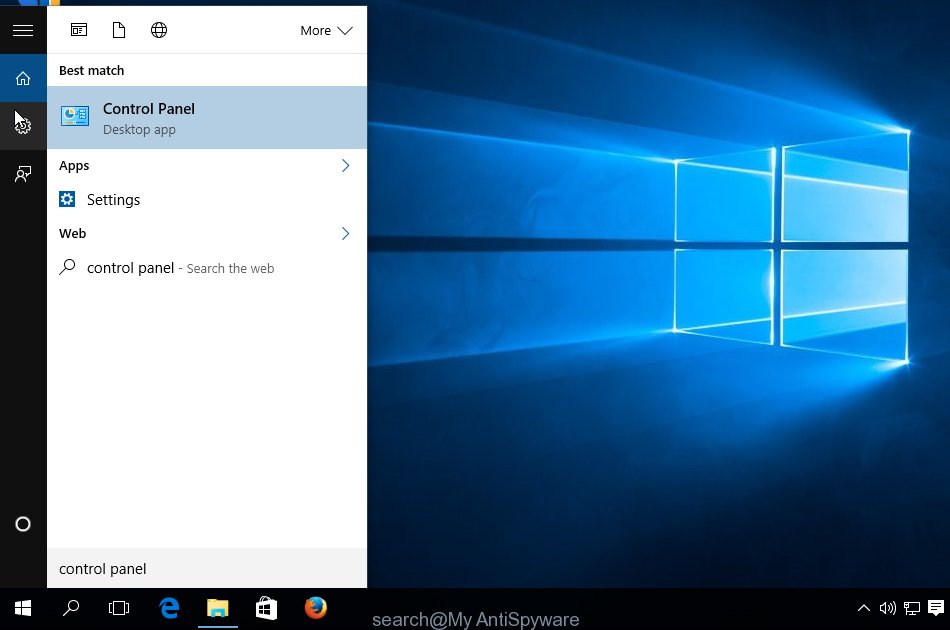
When the ‘Control Panel’ opens, click the ‘Uninstall a program’ under Programs category as shown on the image below.
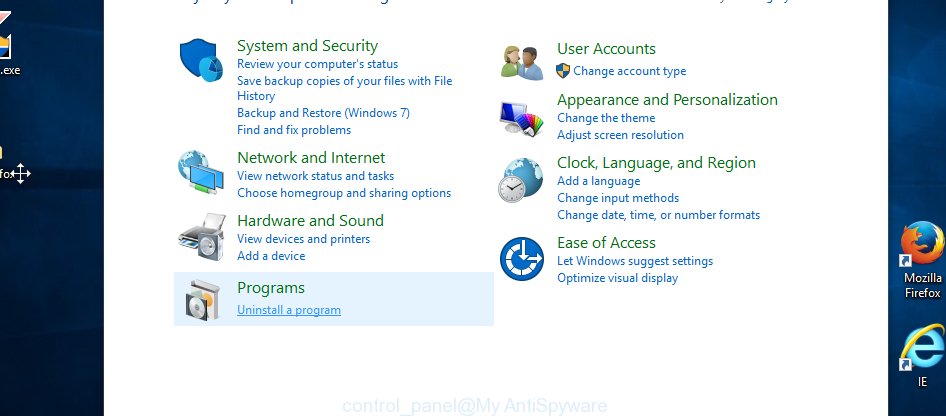
You will see the ‘Uninstall a program’ panel as shown on the screen below.

Very carefully look around the entire list of installed applications. Most likely, one or more of them are responsible for the web-browser redirect to unwanted addonsmash pop-up ads. If you have many programs installed, you can help simplify the search of malicious programs by sort the list by date of installation. Once you have found a suspicious, unwanted or unused program, right click to it and press ‘Uninstall’.
Windows XP, Vista, 7
First, press ‘Start’ button and select ‘Control Panel’ at right panel like below.
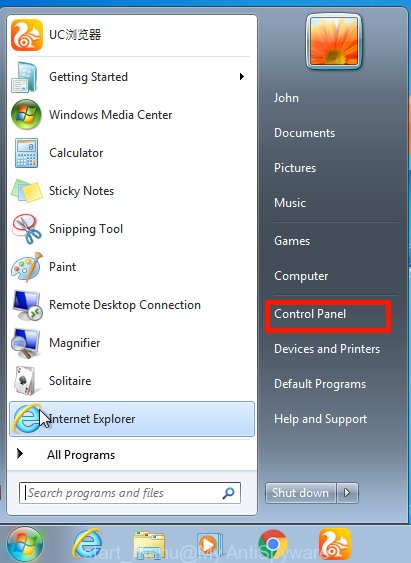
When the Windows ‘Control Panel’ opens, you need to press ‘Uninstall a program’ under ‘Programs’ as shown below.
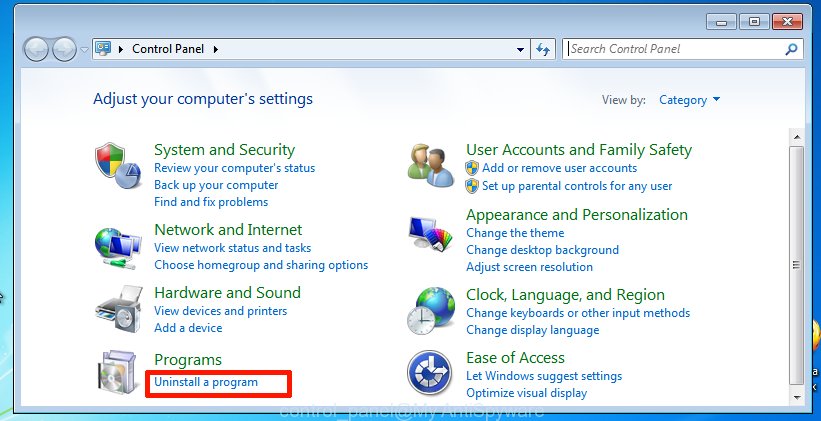
You will see a list of software installed on your system. We recommend to sort the list by date of installation to quickly find the applications that were installed last. Most likely they responsibility for the appearance of annoying advertisements and web-browser redirect. If you are in doubt, you can always check the application by doing a search for her name in Google, Yahoo or Bing. When the application, you need to remove, is found, simply click on its name, and then press ‘Uninstall’ as shown on the image below.
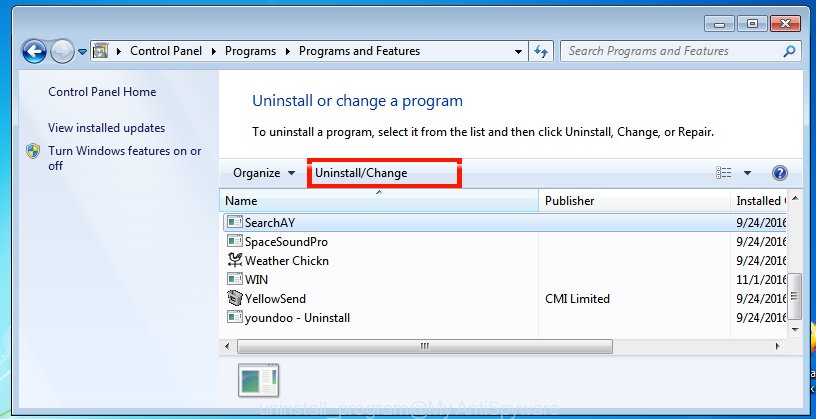
Delete ads by addonsmash from Mozilla Firefox
First, launch the Firefox. Next, press the button in the form of three horizontal stripes (![]() ). It will display the drop-down menu. Next, press the “Help” button (
). It will display the drop-down menu. Next, press the “Help” button (![]() ).
).

In the Help menu, press the “Troubleshooting Information”. In the upper-right corner of the “Troubleshooting Information” page, click “Refresh Firefox” button.

Confirm your action, click the “Refresh Firefox”.
Get rid of addonsmash ads from Chrome
Open the Google Chrome menu by clicking on the button in the form of three horizontal stripes (![]() ). It opens the drop-down menu. Next, press the “Settings” option.
). It opens the drop-down menu. Next, press the “Settings” option.

Scroll down to the bottom of the page and click on the “Show advanced settings” link. Now scroll down until the Reset settings section is visible, as shown in the figure below and press the “Reset settings” button.
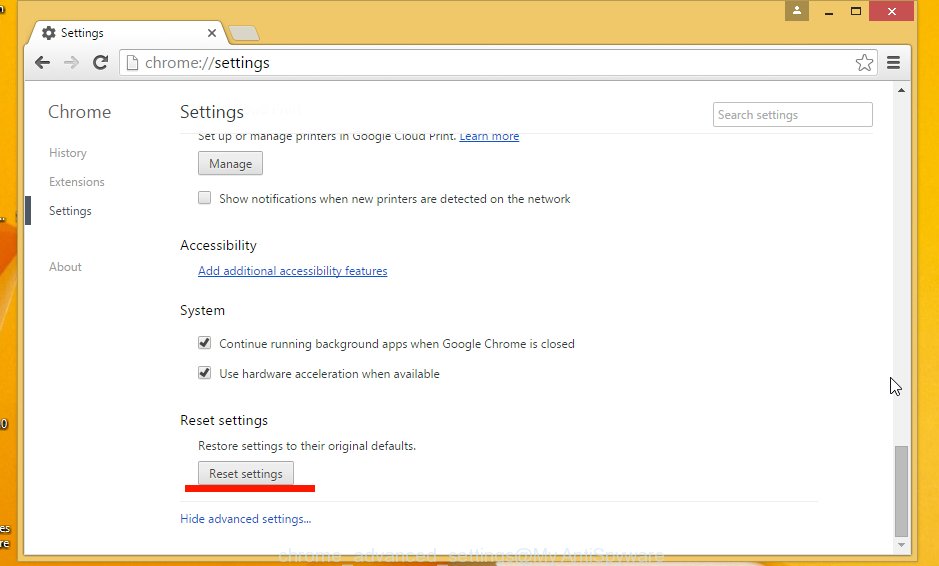
Confirm your action, click the “Reset” button.
Get rid of addonsmash from IE
To get rid of the addonsmash ads you need to reset the Microsoft Internet Explorer to the state, that was when the Windows was installed on your PC.
First, start the Internet Explorer, then click ‘gear’ icon ![]() . It will open the drop-down menu on the right part of the web-browser, then press the “Internet Options” like below.
. It will open the drop-down menu on the right part of the web-browser, then press the “Internet Options” like below.

In the “Internet Options” screen, you need to select the “Advanced” tab and click the “Reset” button. The Internet Explorer will display the “Reset Microsoft Internet Explorer settings” prompt as on the image below. Next, click the “Delete personal settings” check box to select it. After that, press the “Reset” button.

Once the procedure is complete, click “Close” button. Close the Microsoft Internet Explorer and reboot your PC system for the changes to take effect. This step will help you to restore your web browser’s settings to default state and disable ‘ad-supported’ extensions.
Disinfect the browser’s shortcuts
When the ad-supported software is started, it can also modify the internet browser’s shortcuts, adding an argument similar “http://site.address” into the Target field. Due to this, every time you launch the browser, it will be redirected to an annoying advertisements.
To clear the web browser shortcut, right-click to it and select Properties. On the Shortcut tab, locate the Target field. Click inside, you will see a vertical line – arrow pointer, move it (using -> arrow key on your keyboard) to the right as possible. You will see a text that starts with “http://” that has been added here. You need to remove it.
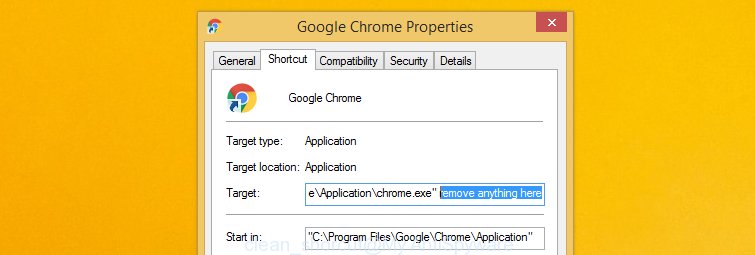
When the argument is removed, click the OK button. You need to clean all shortcuts of all your web browsers, as they may be infected too.
Get rid of unwanted Scheduled Tasks
If the annoying addonsmash ads opens automatically on Windows startup or at equal time intervals, then you need to check the Task Scheduler Library and remove all the tasks that have been created by adware.
Press Windows and R keys on the keyboard at the same time. This displays a dialog box that titled with Run. In the text field, type “taskschd.msc” (without the quotes) and click OK. Task Scheduler window opens. In the left-hand side, press “Task Scheduler Library”, as shown below.
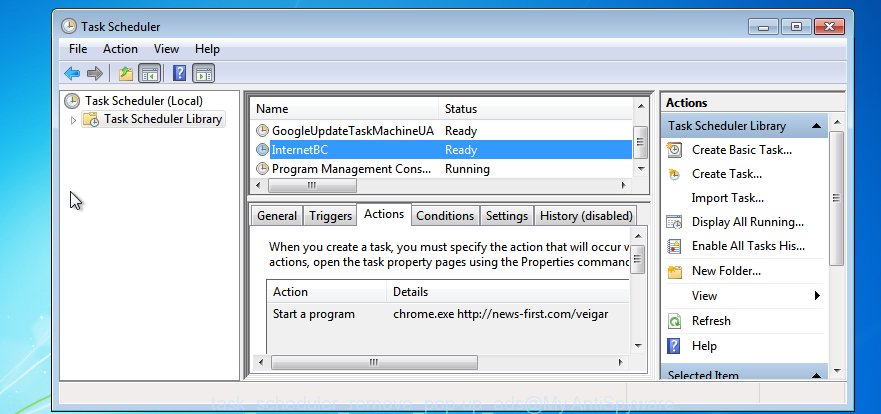
Task scheduler
In the middle part you will see a list of installed tasks. Select the first task, its properties will be open just below automatically. Next, click the Actions tab. Pay attention to that it launches on your PC system. Found something like “explorer.exe http://site.address” or “chrome.exe http://site.address”, then you need remove it. If you are not sure that executes the task, check it through a search engine. If it is a component of the adware, then this task also should be removed.
Having defined the task that you want to delete, then click on it with the right mouse button and select Delete like below.

Delete a task
Repeat this step, if you have found a few tasks that have been created by unwanted applications. Once is done, close the Task Scheduler window.
Remove addonsmash ads with Malwarebytes
Remove addonsmash pop-ups manually is difficult and often the ad supported software is not completely removed. Therefore, we recommend you to use the Malwarebytes Free which are completely clean your computer. The Malwarebytes is a reputable malware removal program. It can automatically detect and remove the adware (also known as ‘ad-supported’ software) of the your system. Moreover, this free program will help you to get rid of internet browser hijackers, malware and toolbars that your computer may be infected too. You can follow the step-by-step guide below to remove the addonsmash unwanted ads completely.
Download Malwarebytes Free from the link below.
327737 downloads
Author: Malwarebytes
Category: Security tools
Update: April 15, 2020
Once downloaded, close all software and windows on your machine. Open a directory in which you saved it. Double-click on the icon that’s named mb3-setup like below.
![]()
When the setup begins, you will see the “Setup wizard” that will help you install Malwarebytes on your personal computer.

When installation is done, you will see window as on the image below.

Now click on the “Scan Now” button . This will begin scanning the whole computer to find out adware that causes the unwanted addonsmash pop-up ads. This task can take some time, so please be patient.
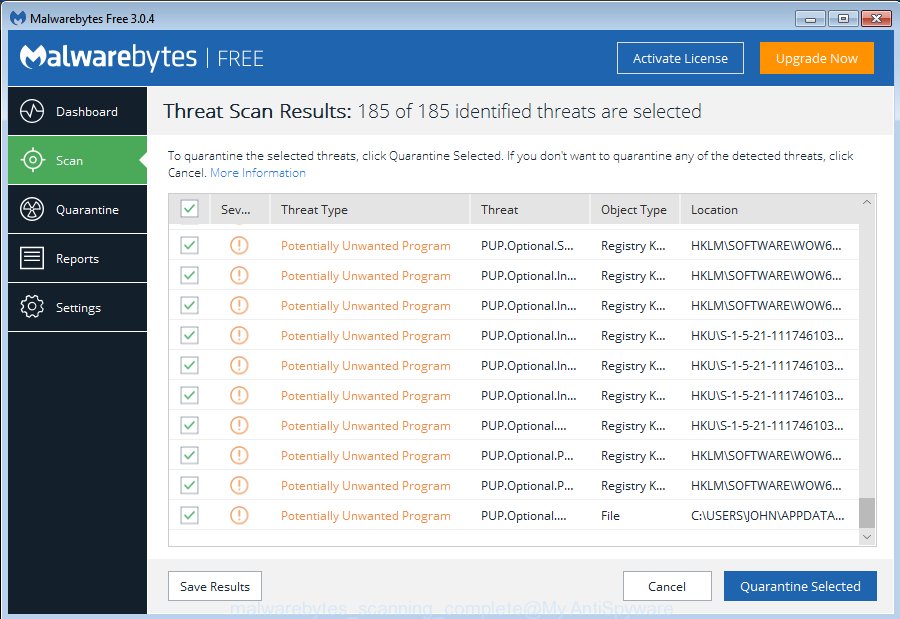
Once the scanning is complete, make sure all entries have “checkmark” and press “Quarantine Selected” button. The Malwarebytes will start removing the adware related files, folders, registry keys. Once the disinfection is finished, you may be prompted to reboot the personal computer.
The following video explains the few simple steps above on how to remove ad supported software with Malwarebytes Anti-malware.
Stop addonsmash advertisements and other annoying web pages
To increase your security and protect your personal computer against new unwanted ads and malicious web pages, you need to use program that blocks access to malicious ads and sites. Moreover, the program can block the display of intrusive advertising, which also leads to faster loading of web-pages and reduce the consumption of web traffic.
Download AdGuard program from the following link.
27038 downloads
Version: 6.4
Author: © Adguard
Category: Security tools
Update: November 15, 2018
After downloading is done, launch the file named adguardInstaller. You will see the “Setup Wizard” screen like below.

Follow the prompts. When the install is finished, you will see a window like below.

You can click “Skip” to close the installation program and use the default settings, or press “Get Started” button to see an quick tutorial which will allow you get to know AdGuard better.
In most cases, the default settings are enough and you do not need to change anything. Each time, when you run your system, AdGuard will start automatically and stop popup ads, ads by addonsmash, as well as other harmful or misleading web-pages. For an overview of all the features of the application, or to change its settings you can simply double-click on the AdGuard icon, which is located on your Windows desktop.
Remove addonsmash pop-ups and malicious extensions with AdwCleaner.
If MalwareBytes cannot remove the unwanted addonsmash ads from the FF, Chrome, Internet Explorer and Edge, then we suggests to use the AdwCleaner. AdwCleaner is a free removal tool for adware, browser hijackers, PUPs and toolbars.
Download AdwCleaner from the link below.
225791 downloads
Version: 8.4.1
Author: Xplode, MalwareBytes
Category: Security tools
Update: October 5, 2024
After the download is finished, open the file location. Double click the AdwCleaner icon. Once this tool is opened, you will see a screen like below.
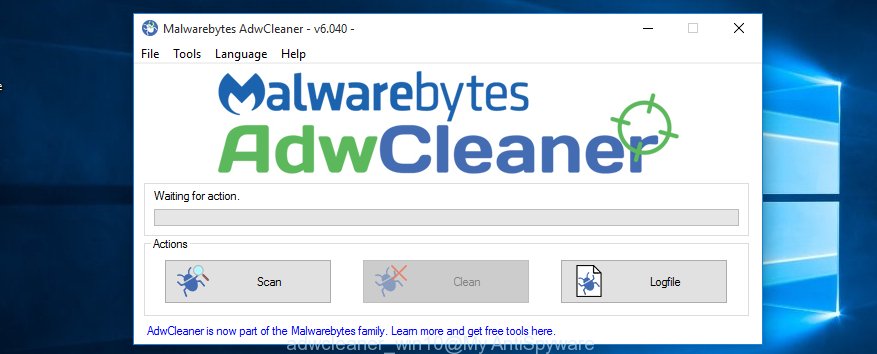
Now, click the “Scan” button to begin scanning your PC for the malicious extensions and adware which shows addonsmash ads. Once the scan is complete, it will show a scan report as shown below.
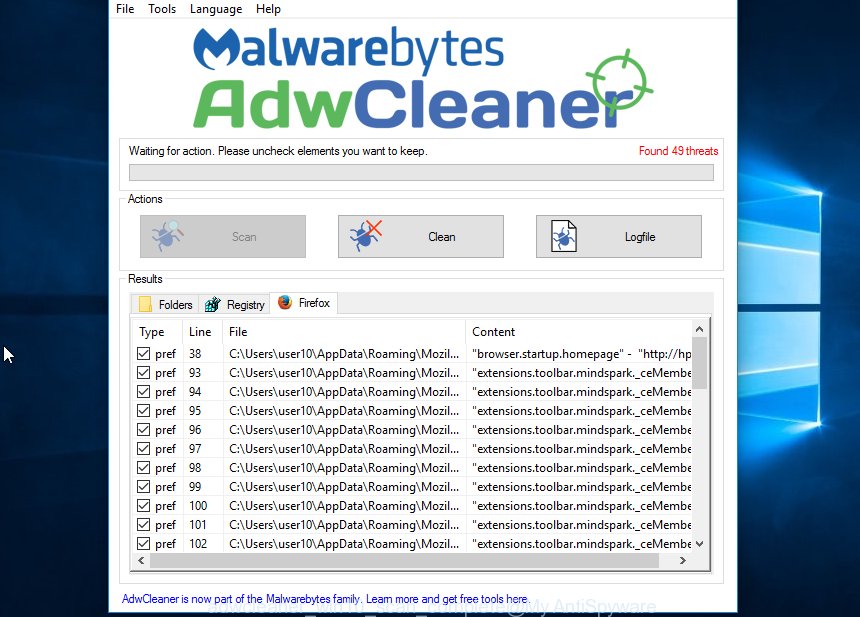
Review the report and then press “Clean” button. It will show a prompt. Click “OK”. Once the cleaning procedure is done, AdwCleaner may ask you to reboot your PC.
Look at the following video, which completely explains the procedure of using the AdwCleaner to get rid of adware, browser hijackers and other harmful software.
Finish words
Once you have complete the guide above, your computer should be clean from malware and adware. The Chrome, Firefox, Internet Explorer and Edge will no longer display addonsmash unwanted popup ads and redirect you to unknown web sites. Unfortunately, if the few simple steps does not help you, then you have caught a new type of ad supported software, and then the best way – ask for help.
- Download HijackThis by clicking on the link below and save it to your Desktop.
HijackThis download
5320 downloads
Version: 2.0.5
Author: OpenSource
Category: Security tools
Update: November 7, 2015
- Double-click on the HijackThis icon. Next click “Do a system scan only” button.
- Once the scan is done, the scan button will read “Save log”, press it. Save this log to your desktop.
- Create a Myantispyware account here. Once you’ve registered, check your e-mail for a confirmation link, and confirm your account. After that, login.
- Copy and paste the contents of the HijackThis log into your post. If you are posting for the first time, please start a new thread by using the “New Topic” button in the Spyware Removal forum. When posting your HJT log, try to give us some details about your problems, so we can try to help you more accurately.
- Wait for one of our trained “Security Team” or Site Administrator to provide you with knowledgeable assistance tailored to your problem with the unwanted addonsmash ads.

